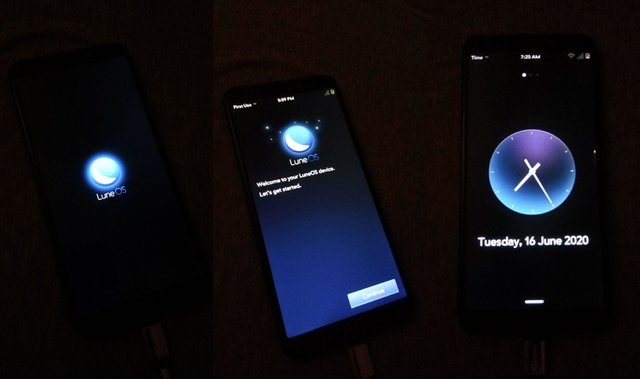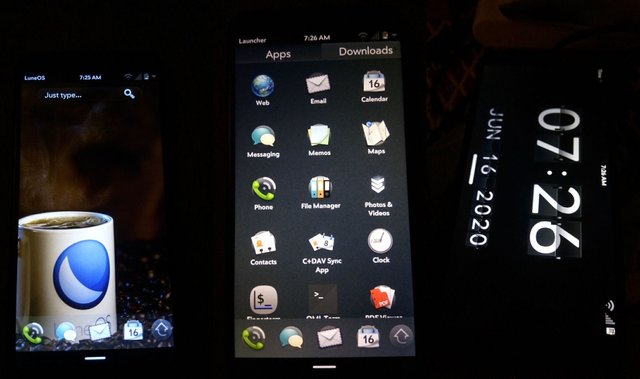Greetings, steemit! My daily research & journey into the Linux-phone world continues!
In a few free hours of my today's work, I'm going to test out some additional distros in the PinePhone list and tell you if there's something that can catch your attention. Let's begin!

Photos with LuneOS boot & clock
Arch Linux
I'm going to tell you that I'm skipping Arch Linux arm for this testing because the goal of this testing is to find a good and ready OS for daily usage or at least OS that's maximally close to that. Arch Linux, while being really nice distro out there, will definitely require a lot of additional fiddling and won't provide any of the choices for you on autopilot. Which is good, if you're building your own distro from scratch, but for this testing, it's just not the perfect way of doing things.
So, we're leaving without Arch Linux for now and hopping onto a totally different boat: KDE Neon.
KDE Neon
As I stated earlier, I am not a big fan of KDE, and that was before I tested Manjaro on the PinePhone with plasma. Now, as I consider KDE might be one of the real options out there for ready-to-use Linux phone, I am going to review the KDE's own distro: KDE Neon.
- First footnote: the image is 800+ megabytes (archived) and 4+ GB after unpacking, which is larger than anything else with an exception for Ubuntu Phone. Which actually might be a good sign! So let's burn and give it a try.
- Second footnote: the image is less than week old. Which is, as in most cases, good and bad at the same time. Anyway, let's test it!
Interface: KDE (Plasma mobile).
Install method: unpacking & writing the image to the microSD card.
When I unpacked the image in the first place, there was an error because of not enough space. Well, 800 MB file unpacked to 8 GB .img image. So I cleaned up my NVME a bit and unpacked again - this time successfully. Gnome image writer ("Disks" app) could not write the image for the first time in the whole test, because the image was reported as about 49 megabytes larger than the micro-SD card size. So I took good'n'old DD for that, as, obviously, most of the image is just "zeroed" space and the system itself is less than 1 gig size as we could see based on the archived image. So I assume there's nothing important in the last 50 megabytes of the image and it would work perfectly without writing the "empty tail" of the file. But we'll see soon!
sudo dd if=./neon.img of=/dev/sdb bs=4M
Sure, this will take some time to write. As I do have a cheap and not very fast micro-SD card. (...after 30 minutes...) finished.
Let's give it a try.. .. .. aaaaand it doesn't boot. Okay. So, for now, images of KDE Neon, as well as Ubuntu Touch, will require 16 GB cards to be tested out. I'll get back to these later.

Photos with LuneOS main screen, applications menu & clock
8. Lune OS.
Interestingly, LuneOS is based on WebOS by LG, comes with Luna Next desktop environment.
Install method: bmaptool is recommended (it downloads, checks, and writes image automatically for you).
Great news, bmaptool finished in just 3 minutes 40 seconds! Let's give it a shot!
Boom! Just 10 seconds after I press the Power ON button I heard the booting sound. It was the first boot sound from all of the 8 OSes that I've tried! That might be a good sign. The LunaOS drops right to the "Starting up" guide; which by the way works in both vertical and horizontal phone modes. Nice. WOW! It shows touches by default. I am ALWAYS turning ON this on Android through a developer menu. And here it is ON out of the box! Cool.
OS itself looks nice and works better than Gnome (Phosh) variants. However, I wasn't able to connect to Wifi (yet again...) so there are no internet connectivity results. Which should be out there, obviously. There's also a nice clock on the lock screen. :)
The OS has some gestures that are really nice, with a sort of Sailfish OS feel. That's probably because OS has some similar ancestors.
However, without solving the situation with wifi, it's hard to tell if it's a good OS for daily usage. At least the sound, brightness, wi-fi search, works. It will require more testing.
Fast-score: 7.3 out of 10.
NixOS.
Pre-build images are not available, so I hopped on into NixOS: downloaded a VirtualBox OVA image, started it, and tried to build one myself. But I met the troubles of cross-architecture build with this VM. The size of VM has grown to 20 + bytes.
If somebody has experience with cross-compiling (especially for ARM64) on the NixOS, please contact me via comments to this post or directly (telegram @fakesnowden).
So, in the end of the day, I skipped Arch, KDE Neon, and NixOS. For today's the only OS that was tested is LuneOS. I will probably wrap up this phone testing (publishing results) in my next post! So stay tuned.
That's all folks, that was my daily post for today.
As always, I want to thank the creators of the competition (@steemitblog and @steemcurator01) as well as those who shared the links and info about this competition (@vipnata and @ladyzarulem). My goal of regular posting to steemit is back! :)
Yours, @sxiii aka D. from O.
а какой-нибудь прикољный андроїдоїд будет тыкаться?
Downvoting a post can decrease pending rewards and make it less visible. Common reasons:
Submit
В перспективе обещают да, и, в частности, есть андроид для платы Pine64 (не телефона, а SoC-платы типа Raspberry/Orange Pi). Вообще исходники все нужные есть, и народ вроде хочет попытаться собрать AOSP или Lineage, но я не нашёл примеров успешной сборки. Сегодня наконец с 10 попытки сам смог собрать NixOS, ура-ура! :)
Downvoting a post can decrease pending rewards and make it less visible. Common reasons:
Submit
о, почитаю, а то я всюду тулил 'феникс', перестал следить за наладонными новостями
Downvoting a post can decrease pending rewards and make it less visible. Common reasons:
Submit